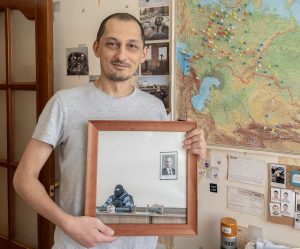According to new satellite data obtained by CNN, a huge base near the Ukrainian border that stored Russian tanks, artillery, and other armour has been entirely vacated, with the equipment presumably being transferred considerably closer to the border in recent days.
The base is located in Yelnya, some 160 miles from the Ukrainian border and southeast of Smolensk. Late in 2021, a large amount of armament was sent there, including 700 tanks, infantry fighting vehicles, and ballistic missile launchers.
Also read: European leaders in Moscow, Washington discuss Ukraine crisis
According to radar satellite imagery taken on February 6, much of the equipment has since vanished. For several days, cloud cover had precluded camera imagery of the scene. The photographs depict the tracks of automobiles that have left the scene.
Maxar’s senior director of satellite photography, Stephen Wood, told CNN, “It looks to me like a considerable amount of the vehicles [tanks, self-propelled artillery and other support vehicles] have departed from the northeastern vehicle park; additional armored vehicles departed from the more central vehicle park.”
According to Konrad Muzyka of Rochan Consulting, what happened at Yelnya is one of numerous “important changes in Russian force compositions and their locations.”
He told CNN, “We are entering the new stage of the build-up where we are seeing pre-positioned units being manned with additional personnel and that equipment is being moved probably to staging areas.”
Also read: Emmanuel Macron spoke with Joe Biden ahead of Moscow visit to discuss Ukraine conflict
Some of those equipment may be seen on trains and roads far further south in the Bryansk region, which is close to Ukraine, in social media videos filmed in the previous few days. The armour and vehicles are clearly from the same pre-positioned troops at Yelnya.
“We know that Yelnya hosts elements of the 41st army of the CMD [Russia’s Central Military District] that arrived from Siberia last spring to a training ground near Voronezh and whose vehicles were later moved to Yelnya,” Rusland Leviev, a Russian journalist who works for the Conflict Investigation Team (CIT), a Russian open-source intelligence organisation, told CNN.
He pointed out that military vehicles with “76” and “87” codes on their registration plates, which identify the CMD, can be seen in social media footage around Bryansk.
“We saw two videos of the same convoy in Smolensk region and then in Bryansk region to the south,” Leviev said, adding that the CIT believes the vehicles are moving to Bryansk because the group “geolocated using crowdsourced dashcam footage and satellite imagery.”
“We also saw videos of several trains that were posted by social media users from Bryansk region. On the carriages we could read 8-digit identification codes, which, when checked against openly accessible databases, trace the train’s origins to Yelnya.”
Also read: UK foreign secretary Liz Truss vows to ‘raise the cost’ if Russia takes further action
“This is important because those vehicles previously were several hundred kilometers away from the border, and now [they] are stopping in mere dozens [of kilometers away].
Thomas Bullock, an analyst at Janes, wrote, “There are now multiple indicators suggesting troops have begun deploying to forward camps to join up with their prepositioned equipment.” He further stated that films shared on social media indicate that troops from Siberia are in the process of deploying, despite the fact that their equipment has already been relocated to Smolensk and Bryansk.
The location at Yelnya was empty in June, according to a US intelligence document dated December 3, 2021, but by November it was home to five Battalion Tactical Groups, each with roughly 1,000 troops and supporting personnel. The 41st Combined Arms Army, which is generally based in Russia’s CMD and has its headquarters in Novosibirsk, Siberia, owns much of the equipment.
According to Muzyka, there are significant Russian movements in other countries. “We are seeing a massive influx of vehicles and personnel in Kursk,” he tweeted Sunday. Kursk is around 70 miles (100 kilometres) from Ukraine’s border.
According to Phillip Karber of the Potomac Foundation in Washington, who has also conducted extensive research on Russian troop deployments, “Russia’s strongest offensive formation — the First Guards Tank Army, which is normally stationed in the Moscow area — has moved south 400 kilometers and is assembling in the optimum area for a rapid armored offensive on the Khursk-Kyiv invasion route.”
Also read: US sending troops to protect NATO territory, not start war with Russia
Jake Sullivan, the US national security adviser, told ABC News on Sunday, “We believe that there is a very distinct possibility that Vladimir Putin will order an attack on Ukraine. It could take a number of different forms. It could happen as soon as tomorrow or it could take some weeks yet.”
Separately, US officials told CNN over the weekend that Russian President Vladimir Putin has gathered 70% of the military forces and weapons needed for a full-scale invasion of Ukraine on the country’s borders.
An increasing force in southern Belarus is part of this.
The Kremlin has denied any intentions for a military strike against Ukraine on numerous occasions.






